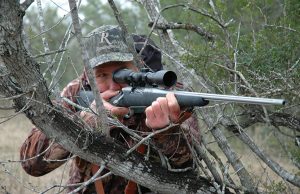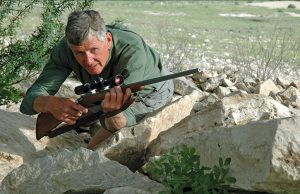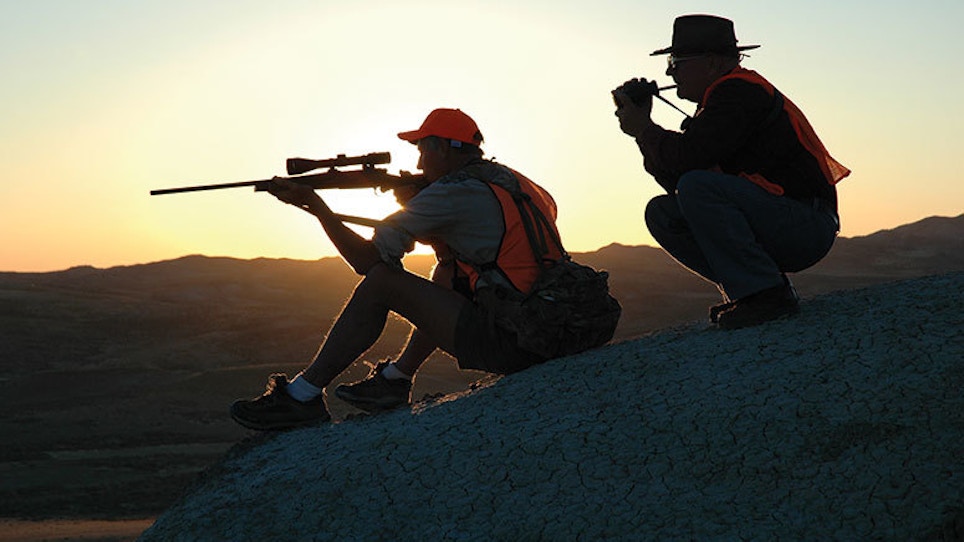You could well have tumbled a sprinting cottontail, a deer dashing for cover, a fox zipping across a meadow. I’ve made those shots on moving game — but the painful truth is I’ve missed others no more difficult. When the target isn’t still, hitting becomes sporadic. As we’re apt to recall the hits more clearly than the misses, we could get the idea that we’re better at shooting-running game than is actually the case.
Thinking well of yourself, my psychiatrist assures me, is healthy. “But I’ll monitor your condition with monthly appointments,” I also hear.
Let me save you some clinical cash. Thinking too highly of yourself can impair your shooting. Even after you concede incompetence — the first step to improvement — you must then work humbly to corral bullets where you want them.
“Just put the dot in the middle and they’ll go in like trained pigs,” declared my good friend Dick Nelson. No argument there. But keeping a tiny black bull’s-eye centered in the sight while triggering a shot “is really hard,” I countered. With a Cheshire grin, Dick told me that’s why rifle matches require live fire.
Because small, still targets look difficult, careful aim comes naturally. With no deadline, you could indeed commit too much time and effort to a perfect sight picture and seamless let-off. The view through a powerful scope shows you not only the wobbles you must control, but the jiggles you can’t. Your hold deteriorates as your eyes and your muscles tire and your lungs cry for more oxygen.
A running coyote absolves you of fine aim. You must fire now or lose the opportunity. Because your target is moving, your rifle can’t be. Its movement erases some of the recticle hop that gives you angst on still, small targets. The smoothing effect of a swing explains why some hunters claim they “can shoot better on running game.” They don’t, really. But hits are expected on still targets, misses quickly buried in the dark vaults of memory.
Aim matters as much on moving game as on bull’s-eye targets, and you’ll hit only if your muzzle is in the right place as the bullet leaves. But the sight will not be where you want the bullet to strike. You must aim in front. Lead or miss.
Get In Front!
Correct lead on moving game hinges on distance, target speed and angle, along with bullet velocity and deceleration rate. If the animal dodges or the terrain adds a vertical component, or if your swing does not smoothly track the target, you must think hard indeed to plan the intersection of bullet and coyote.
“My magnum is so fast I don’t have to lead.” OK. And, “If you like your current health care plan, you can keep it.” Believe what you wish. But those of us who’ve watched dust boil distressingly far behind scooting game accept the cruel truth that all bullets take time to reach their target.
How much time? Say your .243 kicks an 80-grain spitzer — or your .25-06 a 90-grain — at 3,340 fps. Over 200 yards, these bullets have decelerated to roughly 2,680 fps. Mean speed over that distance is 3,010 fps. The effective average is less, as the bullet spends more time at lower speeds (think of trajectory — it’s parabolic, not a rainbow arc). But let’s use 3,000 to keep the math under control. At 3,000 fps, your bullet covers 200 yards (600 feet) in .20 second. A coyote loafing across your sight-line at 8 mph moves about 2½ feet in that interval. Swing with the crosswire on the shoulder, and you’ll miss behind. Swing 2 feet in front and follow through, and the coyote will drop.
your .243 kicks an 80-grain spitzer — or your .25-06 a 90-grain — at 3,340 fps. Over 200 yards, these bullets have decelerated to roughly 2,680 fps. Mean speed over that distance is 3,010 fps. The effective average is less, as the bullet spends more time at lower speeds (think of trajectory — it’s parabolic, not a rainbow arc). But let’s use 3,000 to keep the math under control. At 3,000 fps, your bullet covers 200 yards (600 feet) in .20 second. A coyote loafing across your sight-line at 8 mph moves about 2½ feet in that interval. Swing with the crosswire on the shoulder, and you’ll miss behind. Swing 2 feet in front and follow through, and the coyote will drop.
Say you miss. As you slam the bolt on another round, Br’er Coyote has throttled up. He’s now a 25-mph blur. You swing — and again hit behind. You needed 7 feet of lead! The beast finds another gear; you shove the vertical wire nearly half a scope field ahead. As recoil bumps that improbable sight picture, the coyote melts into the grass. “Thwup.” Your hit floats back.
Had that animal dodged or braked, or suddenly angled away, you would have missed. No math can guarantee a kill.
Now, 200 yards is not nearly as far as the distance some hunters claim to fire with no lead. One fellow told me his .257 Weatherby was light-beam quick, so he could aim “dead on at 300 yards.” Next day he punched a fine mule deer. We followed it up with rifles less magical and killed it. Just as surely as bullets drop, they burn time en route. Sadly, as target range, speed and distance differ, so do ballistic coefficients of bullets. So you can’t assume the same flight time for all bullets starting at 3,340 fps. The .222 can spit 50-grain bullets that fast, but at 200 yards, they’ve slacked to about 2,550 fps, slower by 130 fps than the .243 and .25-06 bullets in our example. A 130-grain bullet launched at 3,340 fps from a .270 WSM reaches 200 yards clocking 2,850 fps — or 190 fps faster than our .24 and .25. So flight time and lead depend on your load.
Because bullet velocities and deceleration rates change over distance, you can’t simply double a 200-yard lead to get a 400-yard lead — any more than you can double 300-yard drop to get 600-yard drop.
The greater the range, the greater the influence of ballistic coefficient.
Snap-Shot, Swing-Through Or Sustained Lead?
Once, still-hunting through heavy cover, I jumped a herd of elk. The animals barreled down a steep hill, the bull splitting from the others. With no time to figure lead, I simply pointed and fired. The bull skidded on his nose. Honestly, I thought my lead was insufficient. My salvation was a fast swing. Rather than sweep my rifle in front, matching the speed of the elk, I’d had to power the rifle to catch up. When the shot broke, my muzzle was moving faster than the bull. My lead was greater when the bullet left than it was when I pulled the trigger.
Some hunters call this “snap-shooting.” I don’t like the term because it implies shooting without aiming. If you don’t aim, you won’t hit. Still, aiming can be done quickly, almost intuitively. Consider the exhibition shooters of old. Saying they hit tossed pennies with .22 bullets without aiming is like declaring that Einstein produced the theory of relativity by stirring alphabet soup. Annie Oakly, Ad Topperwein, Herb Parsons, Tom Frye and others were talented people who practiced fast aim until it appeared to their audiences that they didn’t aim  at all.
at all.
We of lesser talent hit running game without conscious aim for another reason: Our targets are many times bigger than pennies, and most of the animals we hit fall close to the muzzle. Also, the result of an imperfect shot on a running coyote or a running elk may still be a dead animal. Not so if the mark is tiny. Lastly, we seal up our failures — an indulgence not accorded shooters expected to bang every tossed coin in front of witnesses.
At this writing, I just returned from hosting a group of beginning hunters on safari in Africa. The experience was predictably rewarding for them, but the shooting was sub-standard. All the game was standing for the shots, but the primary failing here was lack of familiarity with the rifles. Instead of bringing the sights to bear as naturally as pointing their right hand, these hunters handled the hardware awkwardly.
They looked at it, hesitated when manipulating it, held it away from their bodies instead of tight in. Their movements were slow, halting, calculated. Even still, targets are easiest to hit when you can aim naturally, as if the rifle were an extension of your body. When time is short, fluid rifle handling can make you a star. Quick shots that routinely hit center are neither accidents nor the result of instant reaction. They follow an efficient shooting routine — including aim — that doesn’t waste time.
Predators, or any moving game, dashing across open ground far from the rifle may give you a bigger window, in space and time. As I’m tempted to calculate lead on passing geese with a shotgun, but fire instinctively at quail, I more often use sustained lead on distant animals or swing briskly from behind with my sight and fire as it paints the animal. But refining moving sight pictures is often a mistake. Your best opportunity typically comes early. Delay gives the moving game more options. Often you’re left with a faster target, farther off.






